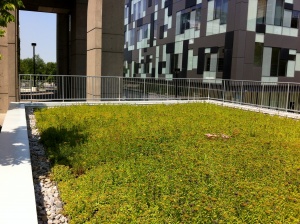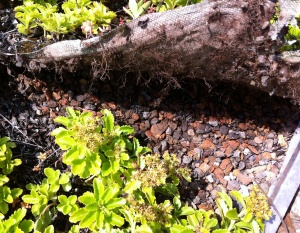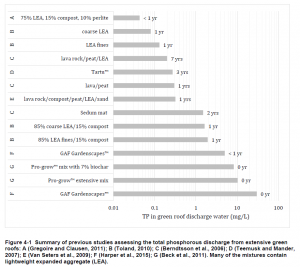Difference between revisions of "Green roofs: Performance"
Jenny Hill (talk | contribs) m |
Jenny Hill (talk | contribs) m |
||
| Line 2: | Line 2: | ||
[[File:YorkU2.jpg|thumb|Detail showing the early root development through the mat to the granular planting medium.]] | [[File:YorkU2.jpg|thumb|Detail showing the early root development through the mat to the granular planting medium.]] | ||
| − | Green roof performance has not been reported to reduce over time. Controlled studies have instead indicated that maturing green roofs may have improved water retention properties <ref>http://www.sciencedirect.com/science/article/pii/S0022169417300768</ref>. | + | Green roof performance has not been reported to reduce over time. Controlled studies have instead indicated that maturing name =green roofs may have improved water retention properties <ref>http://www.sciencedirect.com/science/article/pii/S0022169417300768</ref>. |
The key hydrologic benefit which green roofs have over other forms of LID is the proportion of the water returned to the atmosphere through evapotranspiration. | The key hydrologic benefit which green roofs have over other forms of LID is the proportion of the water returned to the atmosphere through evapotranspiration. | ||
| Line 11: | Line 11: | ||
An appropriate NRCS curve numbers for green roofs without irrigation in Southern Ontario is 90 <ref>Curve Number and Runoff Coefficients for Extensive Living Roofs | An appropriate NRCS curve numbers for green roofs without irrigation in Southern Ontario is 90 <ref>Curve Number and Runoff Coefficients for Extensive Living Roofs | ||
| − | Elizabeth Fassman-Beck, Ph.D., A.M.ASCE; William Hunt, Ph.D., P.E., M.ASCE; Robert Berghage, Ph.D.; Donald Carpenter, Ph.D., P.E., M.ASCE; Timothy Kurtz, P.E., M.ASCE; Virginia Stovin, Ph.D.; and Bridget Wadzuk, Ph.D., A.M.ASCE</ref><ref | + | Elizabeth Fassman-Beck, Ph.D., A.M.ASCE; William Hunt, Ph.D., P.E., M.ASCE; Robert Berghage, Ph.D.; Donald Carpenter, Ph.D., P.E., M.ASCE; Timothy Kurtz, P.E., M.ASCE; Virginia Stovin, Ph.D.; and Bridget Wadzuk, Ph.D., A.M.ASCE</ref><ref name=Hill/>. |
===Water quality=== | ===Water quality=== | ||
Revision as of 01:55, 9 November 2017
Green roof performance has not been reported to reduce over time. Controlled studies have instead indicated that maturing name =green roofs may have improved water retention properties [1].
The key hydrologic benefit which green roofs have over other forms of LID is the proportion of the water returned to the atmosphere through evapotranspiration.
- In Southern Ontario rainwater retention of extensive green roofs without irrigation is between 60% and 70%[2][3][4].
- Including winter periods with snow accumulation and thaw, the annual retention of extensive green roofs is around 50% [5][4].
- Using a compost based planting medium improves retention by around 10% i.e. 60 % for compost compared to 50% for granular.
- Daily irrigation can reduce the annual retention by 20% compared to a roof without irrigation. i.e. 40% for irrigated compared to 60% without irrigation[4]. However, recirculating rainwater from a cistern was estimated to double the annual retention in Florida[6]. The research team modeled 87% retention for a green roof coupled with a cistern, compared to 43% for the green roof alone.
An appropriate NRCS curve numbers for green roofs without irrigation in Southern Ontario is 90 [7][4].
Water quality[edit]
Many green roofs receive only rainwater, which is relatively clean when it lands. As such green roofs can contribute contamination, most notably in nutrient leaching during early establishment. Reported values of total phosphorous in green roof runoff vary from less than 0.1 ppm to over 10 ppm. But, in dense urban centres, green roofs are increasingly being used to receive irrigation from harvested rainwater. Current Ontario Building Code permits the use of rooftop runoff to be reused in this manner, so long as it is 'free of solids'. A 'closed loop' system can be created by coupling a rainwater harvesting system to a green roof. by catching and reusing runoff, the only water leaving the system is through evapotranspiration. This prevents any runoff from leaving the site and so prevents any nutrient loading to the environment.
- ↑ http://www.sciencedirect.com/science/article/pii/S0022169417300768
- ↑ http://www.sustainabletechnologies.ca/wp/wp-content/uploads/2013/03/NRC_EastviewGRrept.pdf
- ↑ http://www.sustainabletechnologies.ca/wp/wp-content/uploads/2013/03/GR_york_fullreport.pdf
- ↑ 4.0 4.1 4.2 4.3 Hill J, Drake J, Sleep B, Margolis L. Influences of Four Extensive Green Roof Design Variables on Stormwater Hydrology. J Hydrol Eng. 2017;22(8):04017019. doi:10.1061/(ASCE)HE.1943-5584.0001534
- ↑ http://www.sustainabletechnologies.ca/wp/wp-content/uploads/2013/03/GR_york_fullreport.pdf
- ↑ http://www.mdpi.com/2073-4441/4/4/914
- ↑ Curve Number and Runoff Coefficients for Extensive Living Roofs Elizabeth Fassman-Beck, Ph.D., A.M.ASCE; William Hunt, Ph.D., P.E., M.ASCE; Robert Berghage, Ph.D.; Donald Carpenter, Ph.D., P.E., M.ASCE; Timothy Kurtz, P.E., M.ASCE; Virginia Stovin, Ph.D.; and Bridget Wadzuk, Ph.D., A.M.ASCE


